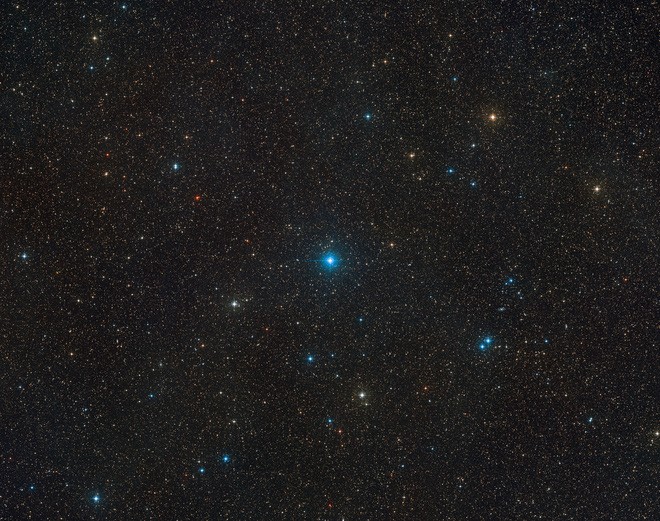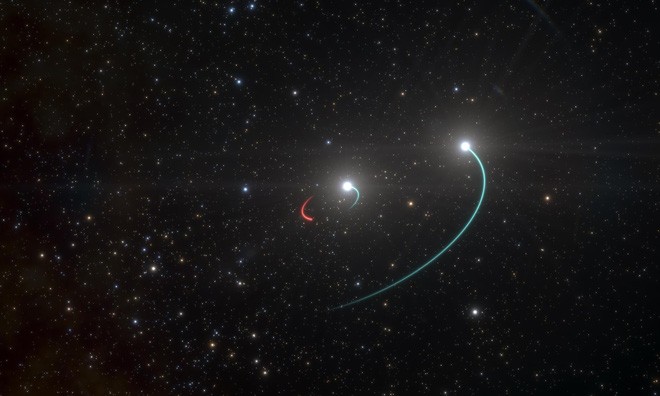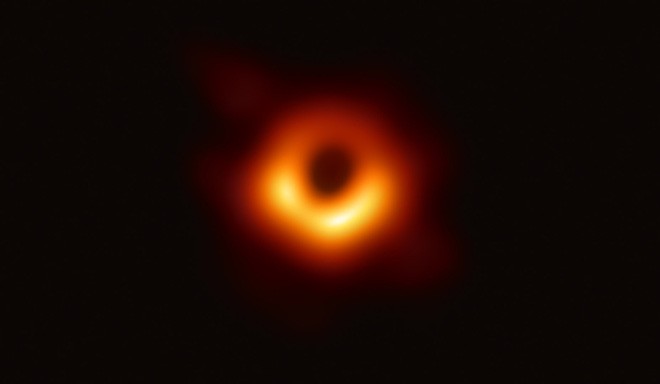Discover the black hole closest to Earth, located in the star system that we can see with the naked eye
Standing in the Southern Hemisphere in winter, you can see a blue dot in the constellation Telescopium. In fact, these tiny dots are two stars flying in pairs, with a black hole closest to Earth ever discovered. The black hole, which is 1,011 light-years away, is located in the star system 6868, has four times the mass of the Sun and is 2,500 light-years away from the nearest black hole.
Compared to the distance a small human could travel, 1,000 light years away. However, in a model with the Earth-Sun distance equal to the thickness of a hair, the HR 6819 star system is only about 6.5 km away. When comparing the vastness of the galaxy we live in (about 100,000 light-years wide), HR 6819 is fairly close; Besides, it is also evidence that black holes are scattered throughout the Milky Way.
' If we find a [black hole] so close, and we assume that our position is nothing special, then black holes must exist everywhere ,' says Thomas Rivinius, working astronomer. at the Southern European Observatory (ESO) and also the lead author of the new study, said.

HR 6819 is the blue dot in the middle of this photo. The two stars in the system are so close together that they form only a single bright spot, and there we have the black hole closest to Earth ever recorded.
Black holes accompany the stars
For a long time, researchers have estimated that the Milky Way is home to hundreds of millions of black holes, but the process of determining the presence of black holes is not easy. In the galaxy we live in, scientists have also seen several black holes are 'eating' clouds of gas near it; gas travels near the event horizon - the edge of the black hole emits radiation, allowing astronomy devices to detect the black hole in space.
However, most black holes in the invisible Milky Way can only be detected by observing the effect of gravity on the bodies surrounding black holes.
The team of HR 6819 astronomers did not purposely search for black holes, they were studying a pair of strange stars orbiting each other.
The outer star is part of a set of Be-stars - that is, a heterogeneous set of stars that have a B-type spectrum and spit out gas - several times bigger than the Sun and burn more violently. Measuring the rotation speed of the big star's axis at the equator, we see the rotation speed reaches 480 km / s. ' It rotates so fast that the star's material almost flies off the surface ,' Professor Rivinius said.
In 2004, a four-month HR 6819 observation showed that this star system was not merely a binary star system. The inner star appears to be orbiting an unknown object, which takes about 40.3 days to complete; meanwhile, the outer star orbits both the inner star and the strange object at great distances.

The artist worked with ESO to illustrate the flight paths of three objects, a pair of stars and a black hole, at the star system HR 6819. The bright colors represent stars, the red colors represent black holes.
In 2009, researcher Stan Štefl, working at ESO, led a new study to track HR 6819 more closely after seeing the trace of a cosmic black hole. But sadly, Štefl professor died in a traffic accident in 2014, research work had to be postponed.
In November 2019, researcher Rivinius, star expert Be and his long-time partner Štefl, found a new reason to once again study HR 6819. A team of astronomers published research on the system the star, LB-1, has a black hole 70 times more massive than the Sun.
The research was immediately put on a scale, because physicists understood how black holes formed from stellar matter - which appeared when a star exploded supernova, that a black hole was so big. does not exist in theory. When a star is capable of producing such a big black hole, it will explode so hard that the star-forming matter cannot collapse into a black hole itself.
However, Rivinius's team found that LB-1's data had many similarities with HR 6819. They tried to identify the mysterious object that was suspended in HR 6819 and based on the inner star orbit. and its brightness, scientists found that the mass of the mysterious object must be 4.2 times larger than our Sun, which is equivalent to the other black holes in the Milky Way we know .
I thought it was invisible but not
If this object were four times the size of our central central star, it would not be a star; According to Dietrich Baade, ESO emeritus scientist and co-author of the new research on HR 6819, why is that size so conspicuous. Besides, it's also too big to be a neutron star.
Excluding all possibilities, scientists only have one concept to explain the strange object's characteristic: it is a black hole.

The first image of a black hole that humans "capture".
However, all studies of star systems similar to HR 6819 have a number of points that have not been clearly explained or even deviated. The distance between the two stars in the pair at HR 6819 is too close for the optical telescope to track, we can only distinguish them through the spectrum of light emitted by the two stars.
In some cases, older stars may have the appearance of younger and older stars. If the inner star of HR 6819 was such a 'stealing figure', the mass of black holes flying with this pair of stars would be wrong.
In the next study, led by new research co-author Petr Hadrava, will attempt to separate the light emitted from the HR 6819 system, clearly distinguishing the two stars. Gaia Telescope, the tool that is mapping the Milky Way galaxy with unprecedented accuracy, will help us to 'investigate' the mysterious mystery of the star system HR 6819. Because this system is so close, astronomers learn can accurately locate two stars.
' Normally, when a star is flying near a black hole, it's impossible to detect a star's movement, ' study co-author Marianne Heida said. ' But this star system is quite close, we can observe it and calculate the mass of black holes easier, if the data match .'
Researchers have been observing the stellar system, HR 6819, in memory of Professor Stan Štefl, who was credited with discovering the black hole before his sudden death. ' Stan is very careful. If he were here, he would look at me and ask: Are you sure? ', Professor Rivinius smiled.
You should read it
- Hubble begins its hunt for hard-to-identify medium-sized black holes
- A new discovery about the strange interaction between cosmic black holes and light
- Detecting monstrous black holes, 20 billion times larger than the sun and growing 'fast'
- Detecting an active supermassive black hole at an unprecedented distance
- Shocking discovery in astronomy: 3 supermassive black holes in the same galaxy
- Discover the most bizarre black holes in the mysterious space universe
- The newly discovered black hole contains anomalous characteristics, challenging most astronomical theories today
- Successfully creating cosmic black holes, demonstrating Hawking radiation exists
May be interested
- The discovery of a giant black hole, 70 times the mass of the Sun in the Milky Way, challenges every theory
 the existence of this giant black hole shocked researchers because it contradicted previous cosmological theories.
the existence of this giant black hole shocked researchers because it contradicted previous cosmological theories. - This is what you would see if you fell into a black hole
 no one knows what will happen when falling into a supermassive black hole like a black hole. to answer this question, nasa researchers created a simulation using the discover supercomputer at the nasa climate simulation center depicting what would happen when falling into a supermassive black hole like a black hole. at the center of the milky way.
no one knows what will happen when falling into a supermassive black hole like a black hole. to answer this question, nasa researchers created a simulation using the discover supercomputer at the nasa climate simulation center depicting what would happen when falling into a supermassive black hole like a black hole. at the center of the milky way. - black hole, white hole, deep hole
 a black hole is a concept that is no longer new to most astronomers and physicists. in this article i will try to write in a short and understandable way possible about the concepts: black holes, white holes and deep holes.
a black hole is a concept that is no longer new to most astronomers and physicists. in this article i will try to write in a short and understandable way possible about the concepts: black holes, white holes and deep holes. - Black box records the process of destruction of the Earth
 the earth black box is a giant steel structure located on the remote island of tasmania. it will witness and document the end of the earth under the effects of climate change.
the earth black box is a giant steel structure located on the remote island of tasmania. it will witness and document the end of the earth under the effects of climate change. - Astrophysics professor teaches how to jump into a black hole so it's 'safe' and possible events
 what if we decide to take the next step: visit, or even go into, a black hole? if you're determined to jump straight into the center of a black hole, you won't regret it.
what if we decide to take the next step: visit, or even go into, a black hole? if you're determined to jump straight into the center of a black hole, you won't regret it. - Hubble begins its hunt for hard-to-identify medium-sized black holes
 throughout the history of astronomical research, anthropologists have found numerous 'small muscle' black holes, with masses 100 times less than that of the sun.
throughout the history of astronomical research, anthropologists have found numerous 'small muscle' black holes, with masses 100 times less than that of the sun. - Close up of the star is said to be a giant structure of aliens
 the tabby star, also known as kic 8462852, is located 1,400 light-years from earth, unusually turned off and then bright, making scientists think of the possibility that it is a structure that aliens have built. to harness the star's energy.
the tabby star, also known as kic 8462852, is located 1,400 light-years from earth, unusually turned off and then bright, making scientists think of the possibility that it is a structure that aliens have built. to harness the star's energy. - The mysterious history of black holes has been decoded by scientists
 one of the common misconceptions about black holes is that they not only swallow matter, but also the history of that matter. the truth about the history of black holes in the universe has finally been revealed.
one of the common misconceptions about black holes is that they not only swallow matter, but also the history of that matter. the truth about the history of black holes in the universe has finally been revealed. - How far is the distance from Earth to Mercury?
 mercury - mercury is a planet located near the sun and takes a little time to spin around the most massive star. so how far is the exact distance from earth to mercury?
mercury - mercury is a planet located near the sun and takes a little time to spin around the most massive star. so how far is the exact distance from earth to mercury? - Found the second planet of Proxima Centauri, the star closest to the sun
 astronomers have recently discovered signs of a second exoplanet in orbit around the star closest to our sun: proxima centauri.
astronomers have recently discovered signs of a second exoplanet in orbit around the star closest to our sun: proxima centauri.










 This is an AI system that can turn people into animals and vice versa
This is an AI system that can turn people into animals and vice versa Impressive image: ISS International Space Station flies over the Sun.
Impressive image: ISS International Space Station flies over the Sun. Why are cartridges usually made of copper and not steel, lead or aluminum?
Why are cartridges usually made of copper and not steel, lead or aluminum? A series of amazing natural phenomena that you cannot see every day, or never in your life
A series of amazing natural phenomena that you cannot see every day, or never in your life This is the first weapon of attack of the US Space Force
This is the first weapon of attack of the US Space Force Science has sought a solution for a billion-year period that has disappeared from Earth's history
Science has sought a solution for a billion-year period that has disappeared from Earth's history